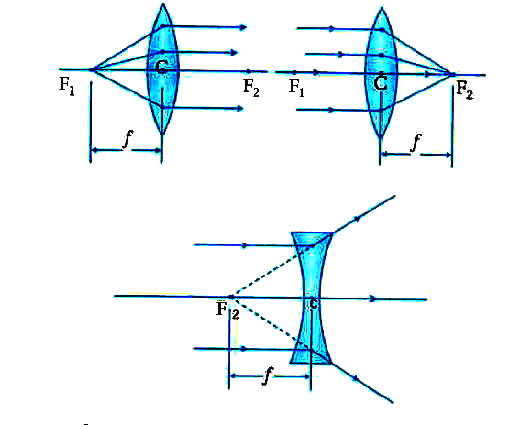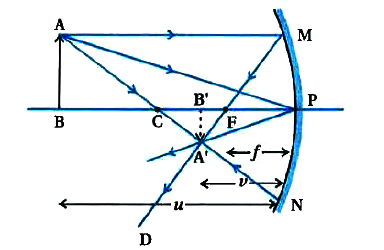For more information about thin spherical lens, define :
(a) First principal focus (F1)
(b) Second principal focus (F2)
(c) Optical centre (C) (d) Focal length (f)
 Solution in Gujrati
Solution in Gujrati
If a point object is placed on the principal axis of a convex lens such that the rays refracted are parallel to the axis figure (a), then the position of the point object is called the first principal focus (F1) of the lens,
If the object is situated at infinite (figures (b) and (c)), refracted rays meet (or appear to meet) for convex (or concave) lens to a point (F2), then the position of this point is known as second principal focus (F2).
The geometrical centre of the medium of the lens is called its optical centre (C).
Distance of principal focus from the optical centre (C) is known as focal length (f) of the lens.
As per the sign convention, f is positive for convex lens and negative for concave lens.
Topper's Solved these Questions
- RAY OPTICS AND OPTICAL INSTRUMENTSBook:KUMAR PRAKASHANChapter:RAY OPTICS AND OPTICAL INSTRUMENTSExercise:SECTION - A (TRY YOURSELF)
Explore 74 Videos
- RAY OPTICS AND OPTICAL INSTRUMENTSBook:KUMAR PRAKASHANChapter:RAY OPTICS AND OPTICAL INSTRUMENTSExercise:SECTION-B (NUMERICALS)(NUMERICAL FROM TEXTUAL ILLUSTRATIONS)
Explore 17 Videos
- MOVING CHARGES AND MAGNETISMBook:KUMAR PRAKASHANChapter:MOVING CHARGES AND MAGNETISMExercise:SECTION D (MCQs ASKED IN COMPETITIVE EXAMS)
Explore 34 Videos
- SAMPLE QUESTION PAPER Book:KUMAR PRAKASHANChapter:SAMPLE QUESTION PAPER Exercise:PART-B SECTION-C
Explore 5 Videos
Similar Questions
Give range of wavelength of visible light.
View SolutionSuppose that the lower half of the concave mirror.s reflecting surface as shown in figure is covered with an opaque (non-reflective) material. What effect will this have on the image of an object placed in front of the mirror ?

View SolutionElectric charge Q having mass M moves on a circular path of radius R with velocity →v, perpendicular to uniform magnetic field B. When a particle completes one revolution, work done by the field is _______
View SolutionTwo charges –q and +q are located at points (0, 0, –a) and (0, 0, a), respectively.
(a) What is the electrostatic potential at the points (0, 0, z) and (x, y, 0) ?
(b) Obtain the dependence of potential on the distance r of a point from the origin when r/a>>1 .
(c) How much work is done in moving a small test charge from the point (5,0,0) to (–7,0,0) along the x-axis? Does the answer change if the path of the test charge between the same points is not along the x-axis?
View SolutionDefine first principal focal length of a convex lens.
View SolutionWith reference to spherical lenses, state the meaning of the following terms or define the following terms and draw the diagrams to illustrate the same : (1) centre of curvature (C) (2) radii of curvature (R1,R2) (3) principal axis (4) optical centre (O) (5) principal focus (F) (6) focal length (f)
View Solutionकिसी पतले लेंस के लिए प्रथम तथा द्वितीय फोकस पद की परिभाषा दीजिए :
View SolutionDefine : Principal focus of a convex lens.
View SolutionAn object placed at a distance of a 9cm from the first principal focus of a convex lens produces a real image at a distance of 25cm. from its second principal focus. then the focal length of the lens is :
View SolutionDefine the terms of principal focus F.
View SolutionThe ……………. is the distance between optical centre and principal focus.
View Solution(a) Define optical centre of a lens. What happens when a ray of light passes through the optical centre of lens ? (b) Define principal focus and focal length of a lens. Draw ray diagram to show the position of principal focus of a lens.
View SolutionDefine the terms: 1 Optical centre 2.Principal axis 3. principal focus of lens.
View SolutionDefine the following: Principal Focus(F)
View SolutionDefine-
First Principal focus.
View Solution